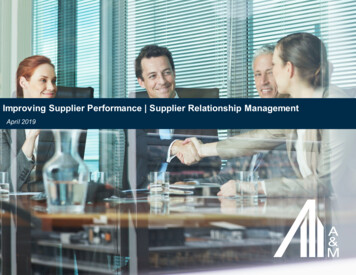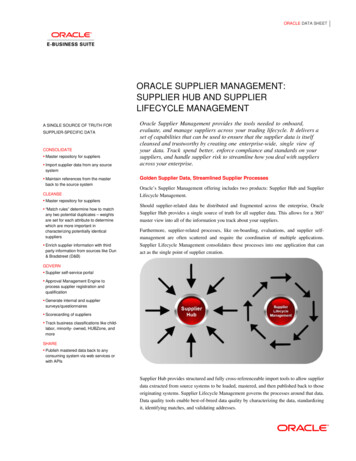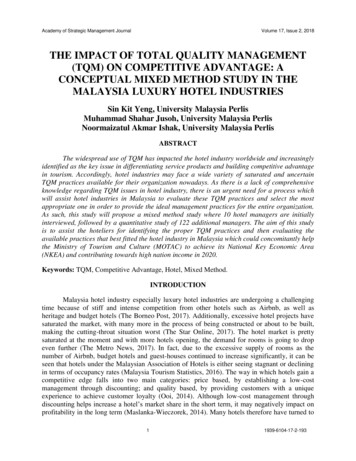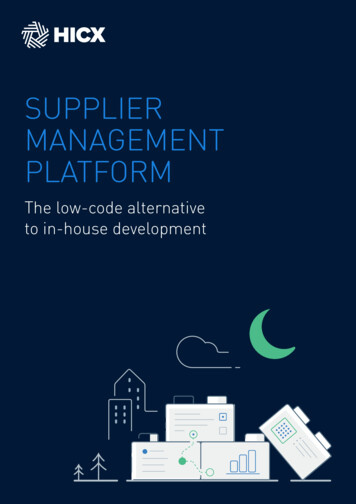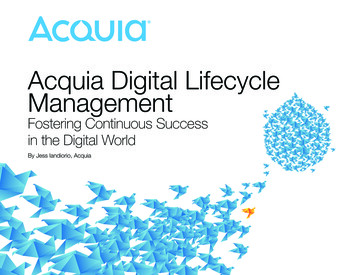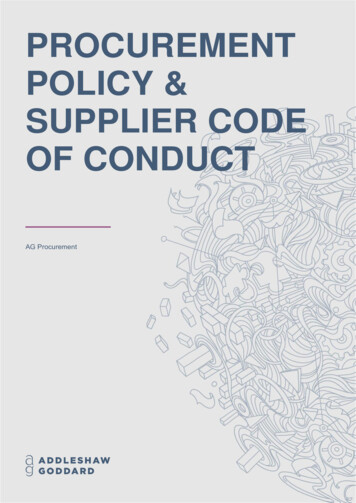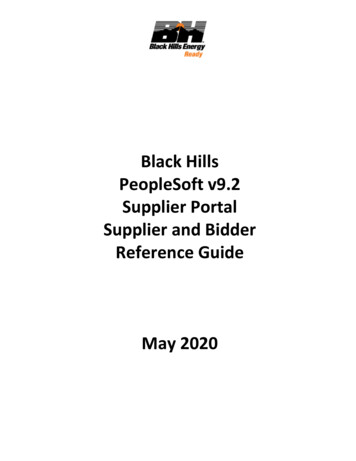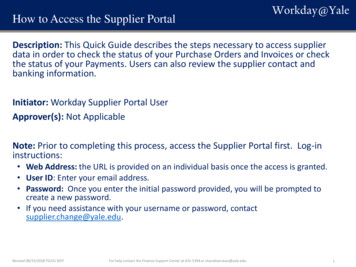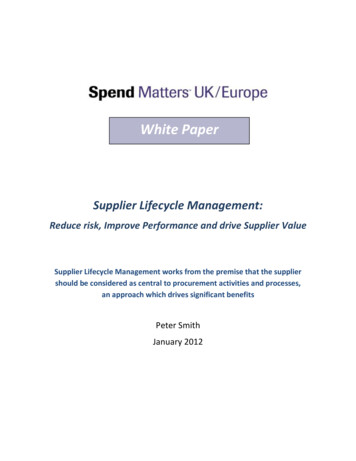
Transcription
White PaperSupplier Lifecycle Management:Reduce risk, Improve Performance and drive Supplier ValueSupplier Lifecycle Management works from the premise that the suppliershould be considered as central to procurement activities and processes,an approach which drives significant benefitsPeter SmithJanuary 2012
Supplier Lifecycle Management: Reduce risk, Improve Performanceand drive Supplier ValueA Spend Matters UK / Europe research paper1. IntroductionThe performance of a supplier has a huge impact on an organisation’s success and will ultimatelydetermine how the procurement function and its leadership will be regarded by the business.A supplier who provides an excellent product and service can provide real value - regardless of thequality of the sourcing process or contract, but a brilliant category management process and bestpractice contract will amount to nothing if the supplier simply fails to perform.Risk of supplier failure or supply-chain failure should also be of vital interest to procurement. Whetherdriven by natural disasters, economic or political developments, or regulatory and compliance issues inthe supply-chain, its importance is growing by the day.Some organisations also face the issue that their suppliers have become so integrated into the deliveryof the end product that they are indistinguishable from the customers’ perspective representing asource of brand and reputational risk.That‘s why choosing the best supplier and then managing them in a joined-up, integrated and consistentmanner throughout their life as a supplier should be at the very heart of everything procurementprofessionals do and care about.This seems sensible, although we often see a paradox; Procurement executives will often complain thattheir own organisations do not fully appreciate the importance of suppliers and their contribution tobusiness success, yet it is clear that those same executives do not reflect this importance in the way theyand their procurement functions think, organise and work.“Supplier Lifecycle Management” (SLM) addresses this central role of suppliers and although a relativelynew concept, picks up on well-known procurement themes, such as value, risk and performance. Thisholistic approach is also becoming increasingly important in the world of procurement solutions andtechnology with some vendors now putting SLM at the heart of their latest product suites.In this paper, we will explore the key cycles in procurement processes and explore what is meant bySupplier Lifecycle Management and its different elements and we will show the benefits that arise fromputting a strong focus on managing the supplier in an integrated and focused manner.2. Process cycles in procurementMost procurement professionals will recognise two fundamental but separate processes or cycles intheir procurement functions; the strategic sourcing process and the transaction (procure to pay) process.They have had a lot of analysis and attention in procurement literature in recent years. 2012 Spend Matters Europe Ltd. All rights reserved.2January 2012
Supplier Lifecycle Management: Reduce risk, Improve Performanceand drive Supplier ValueA Spend Matters UK / Europe research paperThe operational or transactional process cycle is the recording of the transaction, often referred to as“purchase to pay” (P2P). It normally starts with a requisition or requirement, adding a purchase order, adelivery, receipt of goods and services, and concludes with invoicing and payment.The strategic or strategic sourcing process cycle starts with establishing the internal requirement,moves into market and supplier research, then into the supplier selection process (PQQ, RFX etc) andcontracting / negotiation Moving on to post contract award with contract and supplier management invarious forms.Fig. 1 The Strategic and Operational Procurement ProcessesWhile this approach is easy to understand, it has a number of flaws. The cycles are separated and soimportant linkages between them are overlooked, for example, some form of supplier selection mustoccurred in the Transactional Cycle before a purchase order is placed (assuming that random or ad hocdecisions are not made by the budget holder or the buyer).Most importantly, the two cycle approach misses a common and critical factor that runs through theentire procurement task – the supplier. Suppliers are seen almost as a passive recipient of actions,rather than a dynamic, central party to the whole process. Supplier information is key to both P2P andsourcing cycles and supplier master data is the foundation of both processes. Choosing the bestsuppliers and managing their performance to obtain value and minimise risk forms the absolute bedrockof procurement functional and wider organisational success. 2012 Spend Matters Europe Ltd. All rights reserved.3January 2012
Supplier Lifecycle Management: Reduce risk, Improve Performanceand drive Supplier ValueA Spend Matters UK / Europe research paperSo we suggest that a third process should be considered – the supplier cycle, designed to manage thesupplier throughout the entire lifecycle of the relationship should be high on the priority list for seniorprocurement executives. Clearly, the supplier lifecycle links with the other two cycles and is in fact, thecommon thread that provides supplier master data as the foundation and the glue that binds theprocure to pay and the strategic sourcing processes together.Fig. 2 The Supplier Lifecycle3. Supplier Lifecycle ManagementWhat exactly do we mean by Supplier Lifecycle Management and why is it so important? We describe itas “an end-to-end, cradle to grave approach to managing suppliers in a transparent, structured andintegrated manner”.Perhaps more important is the purpose of SLM, which is: to recognise suppliers as a prime source ofvalue to the organisation and deliver that value by putting them at the heart of procurement strategyand management. 2012 Spend Matters Europe Ltd. All rights reserved.4January 2012
Supplier Lifecycle Management: Reduce risk, Improve Performanceand drive Supplier ValueA Spend Matters UK / Europe research paperThe power of this approach is clear. Choosing the “right” supplier (providing validity to a budget holder’schoice) is the most fundamental aspect of the procurement role. There is a strong argument that thissupplier-centric view of procurement, with supplier lifecycle at the heart, should be a key paradigmwhen we think about procurement in our own world and when we articulate procurement to otherstakeholders.It’s a message that can help provide a powerful position for procurement functions and leaders withintheir organisation and fits well with wider strategies.Within private sector businesses, the sales function manages the relationship with the customers, theengineering department manages product design and marketing function manages the organisation’sbrand and product roadmap, there is a clear precedent and clarity in positioning the procurement roleas the manager of the organisation’s suppliers.(A similar parallel exists in the public sector where stakeholder names and nomenclature differ butprocurement still leads in terms of the contribution from suppliers).That positioning is not revolutionary; many progressive procurement organisations have defined theirrole like that for years, But what is more unusual is to find organisations that then base their actualstrategy, systems and processes around this concept. More often, procurement functions are categorycentric, user-centric, contract-centric or (unfortunately) in some cases, requirement-centric (still drivenby the users shouting, “we need this product tomorrow”)!Supplier Lifecycle Management describes a holistic view and set of activities around managing suppliersand so it covers all aspects of dealing with suppliers, from cradle to grave: initial identification and engagement classification and qualification risk assessment and management (throughout the lifecycle, - not just a one-off event) sourcing and evaluation on-boarding and contract implementation contract and performance management supplier development and relationship management (SRM) spend analysis and reporting, and rationalisationTo avoid confusion in terminology, it is helpful to describe how SLM differs from other frequently usedprocess descriptions with somewhat similar acronyms. 2012 Spend Matters Europe Ltd. All rights reserved.5January 2012
Supplier Lifecycle Management: Reduce risk, Improve Performanceand drive Supplier ValueA Spend Matters UK / Europe research paperSupplier Relationship Management (SRM) focuses on the post-contract phase of supplier relationshipsand generally looks at the organisation’s most strategic suppliers and longer-term developmental issues.It is differentiated from contract management in that it goes beyond the focus on a single contract andconsiders the entire relationship between the buying and supplying organisations.Unfortunately, a high proportion of SRM programmes fail. There are many reasons for this and one realworld example had SRM “tacked on” to the wider supplier selection process. This caused a disconnectfrom the rest of the procurement process and lead to a supplier still being treated as part of an SRMprogramme, whilst being excluded from new tenders on the basis of financial instability! The relevantexecutives in procurement and elsewhere in the business were not communicating, and had no joinedup view of what was going on with that particular supplier.Supplier Information Management (SIM) usually focuses on data and information about the supplierand is, in our view, an important subset of the SLM process. SIM generally covers initial informationgathering and on-boarding stages and may also extend to include risk management and ongoingcontract performance information management. It generally does not include the sourcing elements ofthe broader SLM process.Supplier Lifecycle Management encompasses (for relevant suppliers) activities that tend to be labelledSRM, but SLM is far broader in its scope. Supplier Information Management is also a key subset of SLM,but SLM stretches from the first contact with the supplier through to strategic relationship managementand to conclusion of the relationship.In the next section we will explore how the benefits of the wider SLM methodology arise from taking acomprehensive and holistic approach to supplier information, risk, sourcing and contract management.4. The Benefits of SLMTaking a structured approach to Supplier Lifecycle Management delivers benefits from both theindividual parts of the process and those arising from an integrated approach. We can consider thebenefits as falling into four main categories.Process cost reductionThose benefits include greater efficiency for procurement staff, users and suppliers; better planning andlower process costs. For example, collecting and managing supplier information is surprisingly costly andtime-consuming. In addition, the cost of on-boarding is not purely administrative and case studies haveshown that the best organisations can implement beneficial new contracts within days of agreementwhereas other organisations take months, during which time the benefits are being missed. Over the lifeof a relationship with a supplier, far too much time and effort – largely unproductive at that – is spent in 2012 Spend Matters Europe Ltd. All rights reserved.6January 2012
Supplier Lifecycle Management: Reduce risk, Improve Performanceand drive Supplier ValueA Spend Matters UK / Europe research papercommunications of an administrative nature, gathering supplier information, with questions and queriesricocheting backwards and forwards between supplier and buyer.At this point, it is valuable to discuss the importance of “supplier (or vendor) master data”, which lies atthe heart of the entire procurement process. Supplier master data includes the basic details needed tobe able to transact with the supplier and also extended information about company structures such assubsidiaries, that are important to understanding the supply base and support effective spend analysis.Increasingly, it will include details of industry accreditations (health and safety, quality, specialisttechnical) and particular factors that enable organisations to track aspects of their supply base such assize or ownership. Supplier master data is ubiquitous across core procurement processes and souniquely identified, accurate and up to date master data is vital.Risk reductionThe importance of supply chain and supplier risk management has become increasingly appreciatedover the last few years. Unfortunately, both natural disasters (such as the Tsunami in Japan) and manmade (such as the Deepwater oil spill) have highlighted the importance of having a thoroughunderstanding suppliers and supply chains. Risk events can lead to supply interruption or additionalcosts; but more serious are those that cause damage to the reputation of the brand or the wholebusiness. We have seen many of those in recent years!Identifying weaknesses at individual supplier and supply chain level needs robust and up to dateinformation with tracking of supplier accreditations, capabilities and performance through thecontractual period. This all helps to manage, reduce or mitigate the inevitable risk inherent in everyorganisation’s supply chain.SLM provides the basis for proper understanding of suppliers and the risks they present by obtaining,managing and updating the information required for thorough risk management. It helps to ensuretransparency of information relating to the supplier, compliance to corporate standards and policies andreduces the risk of supplier related failures, disruptive events and crises.Aberdeen Group research suggests good risk management can reduce the risk of “supplier crises” by30% for best in class organisations, demonstrating the clear value here. The negative is very evident. Thecost of getting it wrong, or ignoring supply chain risk, can be catastrophic up to and including thesurvival of the entire organisation. SLM also enables the organisation to track policy management issues,such as the desire to support smaller suppliers, minority, veteran or female owned businesses, orpromote the use of local industry and suppliers. This type of issue is steadily gaining a higher profile andimportance in many countries. 2012 Spend Matters Europe Ltd. All rights reserved.7January 2012
Supplier Lifecycle Management: Reduce risk, Improve Performanceand drive Supplier ValueA Spend Matters UK / Europe research paperValue gains from suppliersManaging suppliers well across the whole lifecycle is a pre-requisite for achieving value gains, taking costout of the supply chain and ultimately achieving the best possible value in whatever is being procured.There are drivers for improving value at all points within the supplier lifecycle. Powerful Spend Analyticsgoes beyond providing a basic picture of spend into managing compliance, identifying opportunities forstandardisation and complex analysis around fraud, over-payments or (more positively) identifyingpotential post merger or acquisition savings. The scope for analysing spend data is huge. But it all relieson the accuracy and completeness of the underpinning supplier data.It is an accepted that running an effective sourcing and suppler selection processes drives competition,good value and the right choice of supplier. Holding those suppliers to account through comprehensiveperformance management, tracking KPIs and SLAs, is just as important to overall value. Additionally, ajoined-up view of how suppliers perform across the enterprise is particularly important for largerorganisations and can drive significant performance improvements. For those suppliers wheredevelopment and strategic relationship management are key, post-contract activity assume furtherimportance.Managing compliance, in the sense of ensuring suppliers do what is contractually required of them anddirecting spend towards the appropriate contract and supplier are further key value drivers. Theydepend on a clear view of the supplier, their contracts and the importance of their business with theorganisation.Innovation and “soft” gains from suppliersWhilst the hard value gains are vital to the success of the procurement function and the organisation, itis often innovation gains provided by suppliers that ultimately outweigh pure cost savings. Making useof a supplier’s own strengths and optimising business with them is key and such gains come when thesupplying and buying organisations have close, well established relationships. Identifying whichsuppliers are both important to the business and high-performers is the basis for developing anenvironment in which trust and innovation thrive. Too often suppliers are invited to participate in a“strategic relationship management” programme on the basis of size of spend, with little reference totheir measured performance, the prospects for future business with them, or thought about anyadditional value that could be obtained from the programme.The ability to consider the entire end-to-end view of the supplier and their relationship with the wholeorganisation, will lead to better decisions, working together strategically and capture the supplierinnovation that can deliver real competitive advantage. 2012 Spend Matters Europe Ltd. All rights reserved.8January 2012
Supplier Lifecycle Management: Reduce risk, Improve Performanceand drive Supplier ValueA Spend Matters UK / Europe research paperSLM as an integrated processThe last example takes us firmly into the benefits of the holistic, integrated SLM approach., it is possible,of course, to achieve many of these gains through a series of separate processes, systems andapproaches, but looking at the supplier lifecycle as a single integrated process has undoubted benefits.360 supplier visibility across the organisation allows managing risk holistically across the supply chain toensure that the total impact of supplier failure is understood and mitigating actions are in place; and useof post-contract performance monitoring to feedback into the supplier evaluation process for newcontracts. These are all powerful examples of the SLM process working as a whole and demonstrate thepotential for better supplier performance and value improvement.5. ConclusionsSupplier Lifecycle Management is a new way of looking at the fundamental procurement function.By defining the supplier as the common and central factor in both the transactional purchase to payprocess and the strategic sourcing process, SLM brings together and makes sense of traditional waysof looking at procurement cycles.SLM considers all the elements of our relationship with a supplier, from initial engagement andinformation gathering, risk management, the sourcing process, through the working relationship, todevelopment and on towards final parting of the ways. This holistic approach brings significant benefitsthrough a clear, single view of the supplier and the business with them – benefits that range fromgreater value delivered by our supply base, internal efficiency gains, to improved risk management.Supplier Lifecycle Management can be both the glue to bind together different parts of an existingstrategy to achieve efficiency and the turbo-charge to drive a step change in the benefits derived fromexisting procurement processes, tools and performance.A truly holistic and integrated approach to supplier data, information and management is a huge enabler toachieving benefits across a whole range of procurement actions and activities, from managing compliance,to digging into deeper spend analytics, or getting more out of key strategic suppliers.Few organisations will be starting from scratch; implementing SLM can build on existing processes, toolsand approaches, enabling users to get more out of existing investment and capability. In summary, webelieve Supplier Lifecycle Management to be an important concept for the procurement profession andone that should be embraced as a high priority. 2012 Spend Matters Europe Ltd. All rights reserved.9January 2012
Supplier Lifecycle Management: Reduce risk, Improve Performanceand drive Supplier ValueA Spend Matters UK / Europe research paperAbout the AuthorPeter Smith, Managing Director, Spend Matters UK / EuropePeter has 25 years experience in procurement and supply chain as a manager, procurement director, consultant,analyst and writer. He edits Spend Matters UK / Europe, and with Jason Busch, the founder of Spend Matters inthe US, has developed it into a leading web-based resource for procurement and industry professionals. Peterworked as Procurement Director for the NatWest Group, the Department of Social Security (the DSS), and the Dun& Bradstreet Corporation, and held senior positions in the Mars Group during his management career. He has anMA in Mathematics from Cambridge University, is a Fellow and was 2003 President of the Chartered Institute ofPurchasing and Supply, and his first (co-authored) book, “Buying Professional Services”, was published by theEconomist Books in June 2010.Further information on this topic and others can be found at the website www.spendmatters.co.uk, or we can becontacted at psmith@spendmatters.com. Reproduction of this publication in any form without prior writtenpermission is forbidden. 2012 Spend Matters Europe Ltd. All rights reserved.10January 2012
Supplier Lifecycle Management encompasses (for relevant suppliers) activities that tend to be labelled SRM, but SLM is far broader in its scope. Supplier Information Management is also a key subset of SLM, but SLM stretches from the first contact with the supplier through to strategic relationship management and to conclusion of the relationship.

